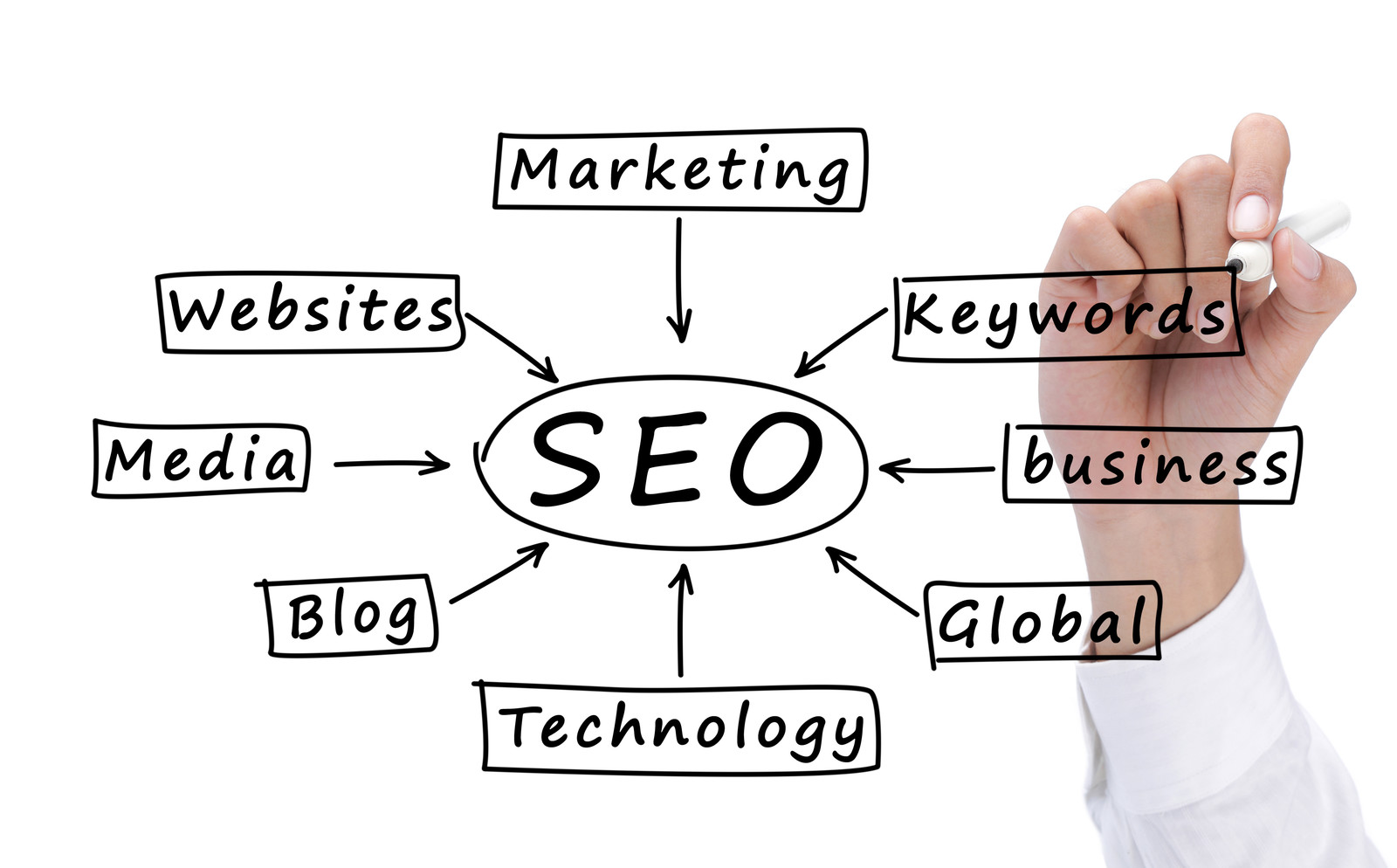
In order to stand out amongst competitors in your industry, you need to provide content on your website that is relative to your market, and informative to your audience.
A website design that includes strong content, along with an exceptional user experience, will increase your search engine optimization and make your business easier to find for potential customers looking for your services. These features will raise the level of trust that search engines put in your business, and in turn, the qualified traffic that comes to your site.
Our integrated marketing team specializes in SEO, content, and online media relations that can help design the necessary content for your website, and strategically market it to solidify your online presence.
A picture is worth a thousand words. When you have a lot to say, sometimes visual media can help alleviate that presentation problem.
Pictures, videos, and infographics give you the opportunity to show audiences what you do, rather than just telling them. It provides content to audiences in an engaging and concise format that is easily sharable through other digital platforms. As a full-service digital agency, we can help to generate the media that can bring a whole new look to the design of your website, and essence of your brand.
Make visitors want to engage with your business through inviting calls to action.
Compel them to get involved by navigating audiences through your website, presenting them with interesting content that keeps them informed and attentive along the way. When used strategically, these CTA’s can lead right to a conversion that feels natural to the customer, and true to your brand.
At Umbrella Consultants, our strategists can create a plan for your website that uniformly fits into the rest of your digital efforts. With a thorough website strategy in place, your calls to action will engage visitors in a way that feels exciting, but still united with your business.
A blog is a great way to create a discussion around your brand. You can generate content covering topics that span throughout your entire industry, and help your company stand out as thought-leaders within your market.
This forms a whole new funnel to drive traffic to your website. An individual can share a blog post that in turn drives new potential customers to your website that want to find out more about your company.
Our content specialists can help design, write, and manage a blog that reflects your business and your knowledge within the industry, while engaging audiences through compelling content.
Social media has allowed audiences to engage with brands more than ever before.
Including access to those channels is a great addition to any website design, especially within blog content. Social media gives you the opportunity to expand the personality of your company, and a lot of customers enjoy connecting with businesses on a casual level.
Our online marketing teams can help to integrate social media into your digital practices, and grow your online audience in order to create a more interactive and engaging environment surrounding your brand’s website.
You want the design of your website to reflect the identity of your company, not just the standards of the industry you operate in.
An effective website design will portray the unique essence of a brand, while still making it stand out against other competitors within your market. Details about the products and services you provide, contact information, and thorough instructions laying out the steps to make a purchase should be available to visitors. Providing the material needed in order to get to know your company will help potential customers more easily find all the information they need in order to confidently make a conversion.
At Umbrella Consultants, we work to get to know the people behind the brand so that we can better your digital efforts. We want to help market your business to an online audience through engaging designs that will grow your brand online.
With the growing popularity of mobile devices, the importance of designing a website that is compatible with all of these platforms is essential.
You want your visitors to be able to view and navigate your website from whatever medium they are using. Whether that be a laptop, tablet, or mobile phone, making sure that your website accessible and functioning in all of these formats should not be overlooked.
Not only does it give you the most value from a business perspective, but it makes engagement easier than ever for the customer.
At the end of the day the most important aspect to a well-designed website, is that it needs to work. Your site needs to function properly, and on a consistent basis.
If a visitor gets to a page and is unhappy or confused by the usability, they are going to leave. Our developers test the quality of each website we develop in order to ensure that they are functioning in the best possible way, and are quick to make changes to alleviate any issues that may arise.
This guarantees an effortless experience for our clients, and an engaging one for their audiences.

SEO is not static. It is always changing and evolving, and those companies hoping to succeed with their SEO strategies need to keep abreast of all of the various changes and trends that could affect their marketing efforts and how they do business. Content marketing is certainly not going away, but you need to understand what you need to do to for it to keep working for you. The following are some of the trends that could affect SEO and content marketing in the coming years.
More than ever, content marketing and SEO need to be thought of in the same context, as they are tied tightly together. Do not separate the disciplines of content marketing and SEO. SEO techniques help you to optimize your content, which can help to drive web traffic to your site.
Some are finding success by creating content that is a bit smaller than what was used in the past. For example, using blogs and articles can work quite well, even when they are 1,000 words and less. The longer forms of content marketing, such as webinars and case studies are not as necessary. However, frequency is important, as is quality. You need great content that is pushed out regularly. The search engines still love to have fresh content, and it can help to improve your rankings.
It is essential that you pay attention to the data that you have access to through your site, your ads, and other sources. The data will let you know what type of content is successful and what does not work well. Find the types of content that do not work for you and stop creating it. You would be better served putting your time and energy into the types of content that do work.
Take a moment to think about how people are searching for content today. While many are still typing into search engines, many others are simply talking to their phones or devices and asking them to complete the search for them. You need to understand the way your customers think to have a better idea of the types of keywords they will use when they are typing and when they are speaking. You might find that you need to alter some of your keyword usage.
Knowing your customer – what they want and how they search – is essential if you want your content marketing to be effective. You will have a better understanding of the types of content they want and expect, and then it becomes much easier for you to deliver. This makes those visitors happy, and it can attract like-minded visitors, as well.
While you might have quality content on your site, if you have poor headlines, it will simply not be as effective. The headlines that you have for the content needs to attract engagement. They should give the reader an idea of what is in the post and make them want to read more. It takes time to get to the point where you can write great headlines that draw people into the content, but it is well worth it to keep at it.
Of course, your headlines also have to be honest. You need to make sure that the content delivers on the promise of the headline. Clickbait articles and headlines might get views, but people have grown to despise this type of content. You want to avoid it at all costs.
While the size of the content might not matter as much as it once did, quality always matters. You need to think about every post that you write and make it as good as possible. The content should not merely be written to add some keywords to lure people to your site. It needs to be entertaining, engaging, valuable, and educational in some way.
Even with your older posts, there is a chance that someone will stumble onto that post through a Google search. You want whatever they find to be as good as possible, because this is someone who is a prospective customer or new faithful reader. You always need to put your best foot forward. This is a trend that will transcend many others in regard to SEO and content marketing.
The biggest competition to SEO marketing is PPC, or pay-per-click. While you might want to utilize some PPC ads, especially when you feel your SEO isn’t working for you, keep at the SEO and content marketing. This is not a technique that is going to suddenly shower you with great results overnight. It takes time. You have to cultivate your SEO strategy and be committed to creating great, optimized content on a regular basis.
When you take the time to invest yourself in SEO and content marketing, it can help you to create a solid foundation for your business and brand. You will have an audience that trusts you. While the “quick results” of PPC might be tempting, do not overspend on that option.
It is important to remember that the only constant about SEO and content marketing is that it will keep changing and evolving. As new technologies are created, whether it is voice search or virtual reality, those who are working with content marketing need to stay abreast of the changes it brings to the field. Be ready to make changes when needed, but do not be too quick to spend money adapting to a new technology that has not proven itself.
When you work with us, you not only get a great website, but you also have some great tools that will help you with the content marketing for your business.
Umbrella has a CMS blog extension, and integration with WebTextTool.com to help you get your content marketing off on the right foot.

Even if you have a great website, you still need to get people to stay on the site and read your content. This means you need to have the best possible content with great phrases to help improve your SEO, and interesting information that will keep people reading and wanting to return to your website.
Improved content can certainly help with this. However, many businesses, whether they are just starting out or they have been building their website for some time now, still have trouble when it comes to creating engaging content. When they hit publish on their content, it goes live, and then the post never attracts anyone. Very few people read it, and there are no comments or shares on social media. It is a virtual version of a tumbleweed spinning through town.
What is it about the content that is not working? There could be several problems with your content, which we will discuss below. Fortunately, they tend to be relatively easy problems to fix.
People who are reading online tend to be impatient. They are accustomed to getting information quickly, and they want that information to be as easy to find as possible. This goes beyond just having a good SEO ranking. When those visitors click on your page, they want the information to be laid out in an organized and easy to read manner.
You want to have plenty of line breaks in the text so your visitors are never faced with a wall of text. Each paragraph should have one to two ideas per paragraph, and those paragraphs should always be as short as possible while still being able to get the point across.
In fact, you can even write some paragraphs that contain just a single sentence.
In addition to breaking up your text into easy to read chunks, you should further break up the content by using subheadings. These subheadings should be compelling and make the reader want to continue. They should include keywords or phrases, and they should provide the gist of what the reader will find in the next section of text.
One of the other great ways to help break up your text to make it more digestible is to utilize bulleted lists. People love lists, and they are easy to read and scan, while providing the readers with some of the most important elements in the text. In addition, they provide a visible difference to the text that will draw attention.
So long as you do not overuse bolding and italicizing, it can be an effective way to make your content scannable and to impart important knowledge quickly. Just make sure that you are not trying to highlight too many items in the text, as this will end up being more of a distraction and a hindrance than help.
In some cases, you might also want to add some links to the content. Utilizing internal links is a fantastic way to have people read even more of your content. However, external links are possible, as well. Try to utilize links that help to support your content and that are from reputable sources.
Today, it is very important to have a large amount of content on your site, and to continually post content if you want to remain relevant. Consider just how many competitors you have out there. If you are not creating content daily, you are falling behind.
Fresh content for your blog compels your visitors to keep returning. It also helps you with search engine rankings.
When people come to your site, they do not want to read rehashes of the same material that you have posted before. Even if you are covering similar topics, as often happens, make sure that you take the time to make each of your posts unique and that you provide people with information they find important.
Keep in mind that “important” will vary based on the type of site that you have. In some cases, it might be putting up content that is entertaining. It might be writing content that is trying to teach someone how to do something. You need to know your audience and what they want, and try to tailor your content around those visitors as much as possible.
There are many different types of angles that you can use when you are creating content, so you never have to worry about it getting boring. The following list includes just some of the things that you can do.
While the content of your site – the written content – is arguably the most important element, you cannot overlook the power of images. People like images, and it can often keep them on a page longer. Finding usable images that are royalty free, or that you have taken on your own, and adding them to your content can help to add visual interest.
Most people today have at least one social media site that they frequent. It might be Twitter or Facebook, for example. You should make sure that you have accounts on those sites for your website, and then start cultivating an audience.
Find likeminded people, comment on their posts, and work toward getting more followers and fans. Post content that will then link back to your blog.
In addition, you should have social media icons on your site so people can easily share the content from your blog with just a click. The more people who share your content the bigger your audience can grow.
When you work with Umbrella Consultants and use the integrated WebTextTool.com features, you will get not only a website, but also tools that can help you to market your business and your content much better.

When many people think of the term SEO, or search engine optimization, they focus on the aspect of keywords. Even though using the right keywords is certainly important, there are other ways that you can improve your website and your overall SEO.
The algorithms in use weigh more than just the keywords you are using;
When you can get users to stay on your page longer and to interact with your content, it can help to improve your SEO. The way to get people to do this is by improving the usability and user experience of your site. Everything should be as user-friendly as possible.
The following are some of the ways that you can improve the usability of your website, which will ultimately help you to improve your SEO.
The term content is king might sound cliché, but it is entirely true. If you want to have a popular and highly trafficked site, you need to have quality content. Good and useful content will keep visitors on your site longer so they can read and engage with the information you are providing.
The ideal length of content can vary based on the type of site you have and your niche. In some cases, content that is between 400 and 500 words is more than enough. However, there has been a trend for longer content as of late.
Having 1,000 words or more provides you with more space to create usable and interesting content. It will also give you more opportunities to work in keywords and keyword phrases naturally to the text.
The longer content – if it is good content – will keep people on the site longer, as well. As mentioned, this can be good news for your SEO.
There are certain things you will want to keep in mind when it comes to the content regarding length.
All your content should be broken up with headings and subheadings. You can also utilize numbered lists and bullet points to help break up the text. People do not want to read giant walls of text, and they won’t. Break it up with smaller paragraphs, lists, and headings.
People today want things instantaneously, and this is certainly true when it comes to reading content online. They dislike waiting for pages to load, and if you happen to have a page that loads slowly, they might just steer clear of your website.
However, visitors are not the only ones who are concerned about the page load speed for your website. Search engines, such as Google and Bing also consider the speed at which a page loads in their algorithms. They do not like sending their users to slow sites, so it has the potential to push your SEO ranking down.
One of the easiest ways to make sure that your site loads quickly is to optimize all your images. You can further optimize your images to work for your SEO by:
While your written content will likely remain the focus of your site, you will also want to consider using video. Video tends to be a powerful medium, and it is affordable for just about everyone to utilize today. Adding video to your site can help to increase interactivity on the site, and it can help to keep people on your website longer.
Videos tend to be liked by the search engines, as well, which will help your SEO. They can be a fantastic way to add to your content, and to provide more interest for your site. The topics for the videos can be similar to those of the usual blog content.
Since videos can take up a substantial amount of space, you might want to consider uploading them to a site such as YouTube, that can host the video. You can then add the video to your site easily.
Social media is a fantastic way to help boost your SEO, as well. You can and should post links to your web and blog content on your social media sites. These links will help with SEO, and they can help more people to find you. The more people who are sharing your content on social media the better.
Keep in mind that social media should be about more than just advertising your own content if you want it to work for you. You should also engage with fans and followers on the site and answer questions if they have them. In addition, post about other elements related to your field, even if you were not the one to write about them.
Today, many people are accessing websites through their mobile devices. They are reading and watching content, and that means your site needs to be mobile ready. The site should look and work well no matter how someone is viewing and interacting with it. Websites and blogs that are not optimized are going to suffer in the rankings.
If visitors to your site leave comments about ways that you might be able to improve, whether it is the layout or the type of content, do not dismiss them out of hand. They are viewing the site through a different lens than you, and they may see problems that you don’t. Look for constructive feedback that could help your site to become better and more usable for your visitors.
Would you like to improve your SEO and bring your site to the next level? Working with Umbrella CMS’s blog extension and the WebTextTool.com integration, it will be easier than ever.

Today, social media is one of the most prevalent forces on the Internet. It seems as if everyone has at least one social media account whether it is through Facebook, Twitter, or Instagram. With so many people gathering on these sites, it is no wonder that businesses have looked for ways to get their attention. Both SEO and social media are organic strategies that have the potential to help bring visitors to your site, and they can work very well together.
If you want to boost your SEO, there are several things you can do via social media that can help. They may take some time, but putting in the effort can be well worth it in the end. Let’s look at the ways you can get started.
Increase the Number of Inbound Links from External Sites
Social media is a fantastic way to get more links from external sites and into your site. When you have these additional links, it can provide you with more authority in the eyes of the big search engines, such as Google. As long as you have great content, it should not be too difficult to get these links, but it will take time.
You need to think of your social media outlets as a way to let people know about that content, and to make it as easy as possible for them to link to the content from their social media profiles and from their sites. Post on your social media accounts whenever you have new content up for people to consume, and utilize hashtags on all of the social media platforms. This can make the content easier to find.
Increase Your Followers
The more followers you have on your social media accounts the better. It means there is a much greater chance of getting people to click on your content and to share the content that you provide.
Just as with most other types of organic efforts, you will find that it tends to take time to grow your followers. Because it is slow going, there is always the temptation to take the easy way out and to buy followers rather than growing them naturally. However, this is a massive mistake. You need to cultivate the right followers, people who actually have an interest in your business and who want to know more about what you have to offer. If you were to buy followers, it would artificially inflate your numbers. The follower count might be high, but it will not mean anything.
When you post great content on your social media sites, the followers will come. You need to be consistent, and you need to remember that social sites should be social. This means you should engage with followers. When they have questions or make comments, reply to them as often as you can.
Quality Posts
Merely posting links that head back to your website or blog will not do you any favors on social media. People need to have a reason to click on that link. Even if you have great content on your site, there needs to be a reason for them to engage. The post needs to have a good intro or title that provides enough information to indicate whether or not your content will apply to readers' needs. Utilize keywords in the text of the post naturally, and consider using hashtags – remember, it makes things easier to find on social media.
Ask for Social Shares
The way to really get your content on social media (beyond your own posts) is to request that people share the content. Many people are more than willing to share the post on their social media as long as the content is quality and they feel it will appeal to people in their circle.
In addition to merely asking for a share, you might want to incentivize it in some way, at least with some of your posts. You could have a contest, for example, and when people like and share posts on your social media accounts, they could be given an entry to win. Keep in mind that the rules for contests can vary with different social sites, and they are subject to change. Check the latest rules before you use this technique, just to be sure it does not violate the terms of the site.
Consider Local Optimization
When you optimize a post for the local area, such as where your business is located, or an event you are going to attend, it can help to increase interest in that specific area. You can also take photos of the event or the locale, and tag them to increase local penetration. This could work well for conventions and tradeshows, for example.
A Great Experience
Overall, your goal should be to provide your followers and fans on your social media sites with the best possible experience overall. Great content, consistent posts to social media, and engaging with the followers can provide you with a growing crowd of people who believe in your company and your brand. When you provide people with a good experience, they are far more likely to share your content and let others know.
Do not make the mistake of ignoring social media or of not using it to its full potential. It is the watercooler of the modern era, and with hundreds of millions of people on these sites, it is the perfect place to invest some of your time to help improve your SEO, as well as your content marketing. If you feel as if social media is taking up too much of your time, or that you are not as effective as you hope on these sites, you might want to consider hiring someone to help you.
You want a strong website and great content that helps to boost your SEO. In addition to using social media, you can use Umbrella’s CMS blog extension and the integration with WebTextTool.com.

Having great content on your website is only half the battle. You also need to make sure that you have the ability to get that content out and in front of people who actually want to consume it. Thankfully, the social media powerhouse of Facebook can help with this immensely. You can improve your overall marketing strategy when you start to use Facebook the right way. It is an ideal option to help promote your business and improve your online reputation.
In addition, you will find that Facebook tends to be one of the more cost-effective ways to improve your content marketing. Here are some of the best ways to use Facebook to your advantage. Best of all, many of these are free.
You Need Followers
If you do not have a large number of followers, you will find that Facebook is not going to do you much good at all. It is only truly effective when you have a large number of followers. However, this does not mean that you should purchase followers. You want to grow your followers organically because they will then be people who actually care about your brand and your business. The fake followers are not going to interact with your content, so do not waste your money trying to buy likes and follows.
Blogging on Facebook
You will want to keep most of your blog posts on your own site. However, you will find that it is a good idea to occasionally post a blog to your Facebook page, as well. They provide you with the ability to blog right on your page, which increases the likelihood that your followers will see it. Not only will they be able to see and engage with that content, but it can encourage people to visit your full site, as well. If they like the content, there is a good chance that they will want more of the content and go to your site. In addition, they are more likely to share the content that they find.
If you do not want to post a full blog on the site, you do not have to. You can provide the title and the first paragraph, and then post that along with a link to your full site. This can act as a teaser that will get them to click on the link. Just make sure that you have a good title and an intriguing description or preview that will make them want to keep reading.
Different Types of Content
While your written content might be the cornerstone of your content marketing, it should not be the only thing that you put up on your Facebook page. You should also consider some of the other types of content that you can post, especially images and videos. People love visual content, and they often provide more engagement and better results. You can post content that you have put up on Instagram or YouTube, for example.
While these can do well when you post them to your site, you will find that they can do even better when you also happen to promote those posts, or boost them to reach more people.
Content from Other Sources
While you might be pushing your own content much of the time on your Facebook page, you still want to walk a fine line. You should not have all of your posts be thinly veiled advertisements that market to the followers. They will not like that and they may even stop following you. Therefore, you need to mix up your content a bit and include items from other sources, such as news that is in your niche.
Keep in mind that the content should generally have some relation to your niche, even it if might be tenuous. What you do not want to do is post content that is too controversial and that is not related to your field. This has the potential to alienate some of your followers.
Communicate With People on Facebook
People who are following you on your Facebook page will often want to communicate with you by commenting on your posts. You want to build a sense of community, so make sure that you are communicating with them as much as possible. Eventually, this might be difficult with a growing number of followers, but do the best you can. Always try to answer questions and take care of any problems before they escalate.
Use Facebook Ads
If you want to put your company and site’s content in front of as many people as possible, you might want to purchase Facebook ads. They are low cost, and you can tailor your ads to target a specific audience. Many choose to promote certain posts that have already done well with their own audience. They feel that it will resonate with others, and they might get more followers, or at least some interaction from the people who see their Facebook ad.
Facebook also makes it easy to do split testing, so you can see which of your ads do the best. This will give you an idea of the type of content that you should post and advertise in the future.
Utilize Facebook Insights
Facebook also offers Insights and Audience Insights, which can give you a wealth of information on the audience you are reaching. You can learn about their general age, location, gender, interests, and more. This information is very valuable, as it will allow you to either create content geared directly toward that audience, or change your content to reach the audience that you feel is ideal.
Facebook is still a fantastic tool. Make sure you are using it properly and making the most out of your Facebook page.
A quality website is the anchor to which you affix your content marketing and improve your SEO. With Umbrella, you will have a quality site, and with the CMS tool and WebTextTool.com integration, you will find it’s easy to improve your content marketing.

People today tend to have shorter attention spans than they did in the past, and part of that is because everything – from food to information – is easier than ever to obtain. Because of this, it means you need to create content for your website that is catchy and that will retain the attention of visitors for as long as possible. Visual content, such as videos, is the ideal way to do this.
In fact, estimates are that by the end of 2017, about 74% of Internet traffic will be from videos.
Videos work very well to capture and hold the attention of your audience. In addition, those who watch videos tend to retain the information better than if they had read the content instead. This does not mean that you should stop writing blog posts – you still need to do that so you can increase your SEO, and there are still people who will read your content.
However, it does mean that you should start seriously looking at ways that you can add videos to your content.
Of course, it is far easier to write a blog post than it is to record a quality video. This is one of the reasons that many still have trepidations when it comes to working with video. They will take time, effort, and money. Still, it might be worth pursuing so you can see just what type of return it is ultimately capable of offering.
Keep in mind that some of the expenses for making videos are one-time purchases. This includes the camera and microphones.
One of the worries that some have when they first approach the idea of making videos is that they will not have ideas to create enough content. However, this is far from reality. With the tips here, and some outside of the box thinking, it should be easy to have plenty of great ideas for videos now and well into the future.
First, you can create videos that are focused on the basics of your niche, whatever it might be. Give people the basic information they need so they can understand what it is you do and what you can offer. In addition, educational videos are always helpful and appreciated. Enlighten people who are unfamiliar with your specialties, whatever they might be.
You can also create video ads, which you can put on your site and YouTube. It is far easier and more affordable to create a nice ad video for the Internet than it is to buy time on television, or radio for that matter. In addition, it has a better chance of reaching a wider audience of the right types of viewers.
Take new information regarding your niche and put your own spin on it for your audience. You could always do some behind the scenes video for your business, whatever it might be. If you have a number of employees, consider doing employee profiles if they are agreeable. You might want to do some reviews, as well as create lists for videos.
Many have also started to utilize videos in their email marketing, and they have had success with increased click through rates, so that may be something you want to try, as well.
There are boundless topics and types of videos that you can make. Look what others in your niche are doing, but think outside of the box to create something unique and that will draw visitors.
If you want to have quality videos, you need to have quality equipment. While the camera on your phone might be powerful, and it might take great video, you may still want to consider getting a DSLR that shoots video, or even a high-quality camcorder that can take great video.
In addition, you will need to have quality microphones that will pick up audio properly. If the video looks great, but the audio is still muddled, people are not going to stick around to watch the entire video.
You will also need to have editing software, and you or someone working for you needs to know how to use that software properly. A well-edited video that looks and sounds great will already be head and shoulders above many of the other videos out there.
If you are unable to make your own videos all the time, it is understandable.
However, you can still have videos on your site that can help to get people to your website and keep them there. You can embed a YouTube video, or add a player depending on how your website operates. You can find videos that align with your niche, which your viewers will see when they come to your site.
Those creators are still getting views and earning through YouTube, if the videos are monetized, but you are getting an increase in traffic.
How Much Time Does It Really Take to Create a Video?
If you want to craft quality videos for your content marketing, it can take time, and it certainly takes effort. The more videos you make the easier it will become, and you will develop certain shortcuts that help to make things faster.
However, you still have to commit to this type of content marketing and be willing to put in the work, or hire people to do it if you hope to have success.
Many have found that it is well worth the time and expenditure.
You can make your site the best it can possibly be, and you want to have great content and strong SEO to match. When you work with Umbrella’s CMS blog extension and WebTextTool.com, it is easier than ever to market your business right.

If you want to have a successful website, it cannot stagnate. The days of having a single static page that you hang out as your “storefront” are long gone. You need to have a site and blog that continually offers fresh content for your visitors. Not only will this help to keep your visitors coming back to your site time and again, but it will also help with your SEO purposes. Google and other search engines like to have fresh content, and if your site doesn’t update very often, it will affect your ranking negatively.
Why Do You Need Fresh Content?
The more often you post, the more often the search engines will visit your site. With enough quality content, it can cause the algorithms to see your site as being valuable for the keywords and phrases that you are using. The same is true when you have more quality external links to your site, but it will be hard to get those links if you do not have fresh content. Over time, when you keep adding great content, it has the potential to help improve your ranking.
When you have more content up, it also means that you are going to be using more keywords for your site. With articles and blogs posted to the site, it will quickly start to increase the keywords on your site. These additional posts are adding to the keywords, and they are also increasing the chance of people stumbling across your site who might become frequent visitors.
Just make sure that you are not creating content merely to stuff keywords into it. The content still needs to be focused on the elements that your readers want and need. Add the keywords naturally. In fact, Google will actually penalize sites that stuff keywords by reducing their search engine ranks.
When you have quality content, it can increase your authority in the eyes of the search engines. Good, valuable content in your field helps to boost your authority from not only the search engines, but from people who find your site. In addition, your readers are expecting new and interesting content, so give it to them. This can ultimately help your brand.
Running Out of Ideas
When people start up their site and blog, they might have some great ideas for their immediate posts. They might have enough post ideas ready to go for two solid weeks. Then, they run out of steam and they have no idea what they should be writing about next. With many, this type of writer’s block can paralyze their creativity, and they only post occasionally.
Fortunately, you need have to run out of ideas. There is always something that you can write about no matter what your niche might be. You just need to take the time to think about how to approach subjects in a different way. Think outside of the box. One of the other nice things about coming up with different types of blog posts is that your readers are never going to get bored. Here are some ideas that you can try if you have been struggling to come up with new ideas. Just find ways that you could apply these to your field and niche.
First, consider the news in your field. This is one of the areas that tends to keep on giving. Look for anything newsworthy, press releases, studies, and the like that might apply to your niche and that the readers might like.
You can also do how-to articles and tutorials. You can write these out, or you could even do a video if you would like. People love how-to information, and you should be able to find at least a few good tutorial options for your niche. It might be something simple, such as how to use a certain piece of software that you utilize in your field, for example.
Another great option for blog posts that are fun to read and relatively easy to write would be lists. People love to read lists, and they often like to talk about the information in those lists in the comments. This can be a great way to try to engage more with your readers.
Reviews can be a nice option, too. You could review products or services that are related to your niche and provide your readers with an unbiased look at an item that they might have been considering. People like reviews, they are helpful, and again, these types of posts can help to get people talking.
You might want to do an interview with someone who is in your field, or even allow someone else to write a guest post. This can help to bring in more readers to your site. You can do infographics, videos, podcasts, and more. There is no reason to run out of content to write about.
Where Do You Find the Time to Add Content?
Of course, when you have all of these ideas to write about, finding the time to write them all can feel overwhelming. It is generally a good idea to work ahead, at least by a few days so you have posts “in the can” and ready to go. You can schedule the posts to go up at a certain time. Ideally, you will be writing a couple of posts as the same time so you are always getting further ahead.
Still, this can be difficult, and you might find that you need to have some help. Consider hiring someone else to take care of some or all of the blog writing and posting duties. This can relieve you of some of the pressure. Just make sure that you read the posts before they go up to make sure they are in line with your brand.
You want to have great content on your site, and you want to have a fantastic site in which to showcase it. You can use Umbrella and the integrated WebTextTool.com to help create a quality site that is also perfect for improving your SEO and marketing your business.

Everyone tells you that if you want to have more visitors and a more successful business, you need to focus on your website, which really means improving your content marketing. Many people simply nod and start thinking about keywords and articles they can write.
However, there are more things you need to do to ensure you are creating the best content possible. It is not too difficult, though. The following tips should help to keep you on the right path when it comes to improving your content marketing.
Identify Your Target Audience
You know your audience better than anyone else does. Who are you trying to reach with the content that you are creating and the items or services you might be selling? What is the ideal customer? What types of problems do they have? The more you know about this demographic and ideal target audience, the easier it will be to focus on creating the right type of content for them.
Choose the Right Keywords
While keywords are certainly not the only element of good content marketing, they are still important. Once you know your audience and the type of content that they might want to read, it becomes easier to choose keywords. The keywords that you choose should cover all the aspects of your products or services.
Knowing the right keywords to use is only half the battle, though. You also need to make sure that you are using them properly. They need to be distributed naturally in the content. Overusing keywords and stuffing them into the content not only creates text that is difficult to read by humans, but the search engines will penalize sites that do this.
Good Content
Everyone says you need “good content”, but what does that really mean? It simply means that you need to have content that your target audience will find useful or entertaining. The content needs to be compelling enough that they want to come back to your site. It should help your visitors to see you as an expert or someone who is highly entertaining.
One of the ways that you can do this is to write about topics in your field from a different angle. You can create lists, do reviews, and add a bit of personality to each of the posts. This helps to set you apart from the competition.
Proof the Content
It is also important that you take the time to proof the content before you hit publish and send it out to the world. No matter how careful you might be, it is easy to miss some spelling or grammatical errors here and there. It happens to the best writers. Once you have gone over the content, you might want to have someone else on the team read it as well, just to make sure it is ready to go live.
Evergreen Content
While you might want to post news items and timely reviews, you should also strive to post evergreen content. This is simply a term used for content that will be as helpful and interesting today as it will be ten years from now. These are long tail pieces of content that can continue to work for you and help you get readers for years.
Not all the content needs to be evergreen, but you should strive for at least 25% of evergreen content. This percentage could be higher depending on the type of niche site you are running, naturally.
Post Consistently
One of the problems that many sites have is starting off strong and then sort of fizzling out. They might post daily for the first couple of weeks, and then find that they do not have as much time as they had wished. This leads to missed posts here and there, and that inconsistency means readers stop coming to the site. It also means your SEO is going to suffer if you are not posting regular, fresh content. Get into the habit of posting. Another tip below – working ahead – will help.
Watch the Competition
To create better content, check out what the competition is doing. This does not mean you should be copying them, though. Look at the sorts of content they are creating to get ideas on how to create your own better content.
Consider Using Different Formats
You can also consider working with some different formats to help increase interest in your content. Most of your content can still be written, but consider spicing things up with some videos or image galleries here and there. You might also want to create some infographics.
Work Ahead
As mentioned, it can be difficult to keep up with regular posting. However, if you work ahead, it can make things substantially easier. You can create full posts that are ready to go and that you schedule in advance. You could also create some rough drafts so that finishing them up is fast and easy. In addition, you should have a list of potential topics that you keep adding to, so you never run out of ideas.
Monitor Your Progress and Adjust
Content marketing is never a “one and done” part of your business. You need to keep track of your content marketing successes and failures, you need to check analytics to see what is and is not working, and you need to be willing to make changes and adjustments to improve your content marketing strategies. This is an ongoing challenge, but it is essential.
These are some of the easiest ways to help you improve your content marketing, and you can start with these tips right now. Get your site’s content up to par and impress your visitors.
You want to have a high-quality website, and that’s where Umbrella can help. Not only will you get a great site, but with Umbrella CMS’s blog extension and the integration of WebTextTool.com, it is easier than ever to market your business.

No matter how popular your website might be, you can always keep working toward improving your search engine optimization. Better and stronger SEO can keep pushing your site upward and onward, but sometimes, it can be hard to understand exactly what you should be doing to make your SEO better. Fortunately, there are some good methods that will help to put you on the right track and that will improve your site’s SEO with just a bit of effort and time.
Make the Content Unique
There is the cliché term of content being king, but it is entirely true. Great content marketing, and improved SEO will rely on having quality content. This content also needs to be unique if you want to succeed. Sure, there will be some overlap with other sites when you are discussing certain things. However, you should try to come up with a unique way of presenting the content, such as through the voice and personality that you add to the site.
Also, make sure that you are never directly copying content from another site. This will cause problems for your site that you don’t need.
Keep Up With the Content
In addition to having unique content, you need to make sure you also have fresh content. This means you need to have new content posted regularly to your site or blog. The search engines are looking for new content, and if your site provides quality content regularly, it will improve your search engine ranking.
Ideally, you will always have plenty of content that is ready to go up on your site. Try to work ahead whenever you can so you do not have to worry about having a dry spell.
Use Alt Tags
If you have other types of media on your site, such as video and images, you should make sure that you are using alt tags. This simply means alternative text descriptions for those items. When you provide a good description of those pieces of media, it can allow the search engines to find your page. While this tip, and the metadata tip that follows, are not considered as important as they once were by some experts, they can still help.
Metadata
You should also make sure that you are inserting metadata into your page content. You can add the title metadata, description metadata, and keyword metadata. The title metadata is the text that shows up for page titles at the top of a browser’s window, and is considered to be the most important metadata for a page.
Description metadata is the text description a browser uses in the page search return. This gives a small description of what is included on the page and can entice someone to click on that link. Keyword metadata includes the search phrases people type when they are trying to locate your page. You should keep the keyword metadata to between six and eight phrases, and they should be four words or less each.
Make Sure You Are Mobile Compatible
With so many people today accessing the web through their smartphones and tablets, you need to think about how your site appears on those devices. You need to have a site that has been built to work seamlessly in all devices or that is responsive and can adapt to those sites.
If you don’t, you run the risk of alienating a large portion of your potential audience. They are not going to read the content, and they will not be able to share the content. This can ultimately hurt your SEO.
Make the Site Easy to Navigate
When people come to a website, they expect to be able to find what they need quickly and easily. If you have confusing navigation on your site, people are not going to stay for very long. Like with sites that are not mobile compatible, people are not going to share the content. The aesthetics of the site, along with the internal architecture all need to be working together if you want people to keep coming to the site.
Sharable Content
Your content should be sharable. This goes beyond merely having good content. You need to make sure there are ways that people can easily share the content. Have social buttons on your content, so people can share with just a single click to places such as Facebook and Twitter.
In addition, you need to have social media sites set up for your business, and you need to post to those sites every time you put up new content. The followers and fans that you have on Twitter who are looking at your content can then easily share it right from their own feeds. Social media is powerful, and it can boost your SEO; do not overlook it.
Beyond the Blog
While the text blogs and articles are great for increasing your SEO, you might decide that you want to branch out and add other types of content. For example, video content and audio content are two popular examples. This can add a new dimension to your content, and it can provide you with other content marketing outlets, where you could find even more potential visitors for your site.
Review the Efforts and Change the Plan
Just because you have a good plan in place for your SEO and content marketing right now, it does not mean it is the best plan. You need to take the time to review the successes of your efforts and look for areas where you can make some changes and improvements. Check your analytics to learn more about your visitors, change your plan, and then repeat. Improving your SEO is an ongoing effort.
You want to have great content and SEO, and you need to have a quality website that works well for your visitors once they arrive. Umbrella can provide you with a great site, and the CMS tool and WebTextTool.com integration makes it easy to great content up onto the site.

Social media marketing is a “must” for small business today. You simply cannot afford not to engage in it. However, you need to make sure that you’re using it the right way. Rather than utilizing it to create a constant stream of “look at me” promotional posts, it can be integrated into your content marketing campaign quite easily.
The problem here is that many small business owners aren’t really sure how to use social media for marketing purposes in the first place, much less as a component in a content marketing campaign. What should you do? What types of content will work? How do you ensure you’re reaching your audience? What else do you need to know? We’ll discuss all that and more in this article.
First, you need to make sure that you’re using the right content. This touches on a number of different areas – the right content for your audience, and the right content for the social media platform in question, to name only two.
What type of content should you be using? Again, this will hinge on the platform in question. If you’re marketing through Instagram, it could be a behind the scenes photo of your newest product in action, or of your team going to work on a customer’s property with the appropriate hashtags. If you were using Twitter, it could be a link to something more – a whitepaper on your website, for instance. If you’re using Facebook (and you should be), then it could be almost anything, although images get more attention and more shares. Here are some of the more popular types of content to incorporate into social media marketing:
· Infographics: Infographics can be shared “as is” through most social media platforms. They’re images, which immediately grabs your followers’ attention, and they’re highly shareable, as well. Make sure to include links to your site at the bottom of the image, as well as your company name and logo.
· Blog posts: Blog posts can be shared through pretty much all social networks, but Twitter and Facebook are probably the best suited for it. LinkedIn can be a good option if you’re in a B2B vertical. Make sure to use an image at the top of your post so that it shows prominently on the network.
· Reports/whitepapers: Reports and whitepapers can be good content to share on social media, but it’s actually better to share the landing page where your visitors can download the content, rather than the content itself.
· Ebooks: The same thing applies here as to reports and whitepapers. Share the page where your audience can download the ebook, not the ebook itself.
One of the most important parts of using social media correctly is to ensure that you’re sharing content that your audience wants. In most instances, they want images. Even on Twitter, images are king, and you can boost retweets by up to 150% if you include an image in your message. Images can be funny, thought provoking, informative or entertaining.
In all instances, make sure that the image ties back to your website – a watermarked URL on the image if nothing else. Not only will using images more frequently help boost the number of shares you see, but it will increase engagement, as well. You might be surprised at how many people comment on the pictures who never would have bothered on another type of post.
Yes, social media marketing is a powerful tool, but it’s more like a scalpel than a sledgehammer. You can’t really hit your audience over the head with direct marketing message after direct marketing message and expect them to stick around. You need to become adept at marketing obliquely – marketing around corners, if you like. What does that mean?
Simply put, it means that you need to learn how to market without being overt about it. Keep the heavy-handed sales tactics for other avenues, and focus instead on being an important part of the community. Share posts that contain important information for your audience. Share information from other sources (not direct competitors). Share humorous content. The point is that you need to be “social”, and that implies doing more than just hammering out marketing-related ad after marketing-related ad.
Pretty much all social media platforms these days offer some form of marketing. Facebook is the most prominent (and the most useful), so we’ll focus on that. You need to combine content marketing and social ads. This doesn’t need to be a costly endeavor, though. A quick boost for $10 can put your content in front of thousands of new potential customers. Increasing that boost to $20 can have even greater ramifications.
Use boosting and social ads strategically, interspersed within your wider social media marketing campaign. Use these tools to amplify the reach of your content marketing efforts, and you might be surprised at just how quickly your audience grows, and how little you have to spend in the process.
Sure, you probably have an idea of who makes up your audience, but you need to take things a step further. Your content needs to be written for a specific buyer persona – you’re essentially writing directly to this fictional person. That can carry over to your social media efforts. Know your audience, and share posts that resonate with them. Use buyer personas to help ensure that your content reaches farther and resonates more with each member of your audience.
These five tips will help you get more mileage out of both your content marketing and your social media marketing efforts. However, don’t believe that they’re all you need to be doing. Online marketing is constantly evolving, and you need to stay at the leading edge in order to ensure that you’re still reaching your audience.
 Keywords – your online visibility is built on them. Your customers’ ability to find you online without knowing your website’s actual URL rests on using appropriate keywords. Your ability to outperform your competition rests on the use of the right keywords. As you can see, they’re pretty important, but it can be quite confusing for small business owners who aren’t familiar with how to choose the right keywords, or how to implement them in their websites. What should you know about choosing the right keywords and phrases? Let’s take a closer look.
Keywords – your online visibility is built on them. Your customers’ ability to find you online without knowing your website’s actual URL rests on using appropriate keywords. Your ability to outperform your competition rests on the use of the right keywords. As you can see, they’re pretty important, but it can be quite confusing for small business owners who aren’t familiar with how to choose the right keywords, or how to implement them in their websites. What should you know about choosing the right keywords and phrases? Let’s take a closer look.
1. Use the Right Tool
Chances are good that you think you probably have a pretty good idea of what terms your customers might use to find products or services like yours online. And, there’s a good chance that you’re at least partially right. However, never assume that you know all the potential keywords, phrases and variants that your customers might use to search the Internet. This is why it’s so important that you use an accurate keyword research tool to figure out what keywords you’ll target. Google’s keyword planning tool is free to use, but there are many others out there worth your consideration.
2. Use Your Competitors as Inspiration
While you may not want to target all the same keywords as your competitors, as that would drive up your costs and the competition for each one, you should take a cue from what they are doing. You’ll find that this can provide you with considerable information about keyword phrases, long-tail variants, and even the density that you want to hit with your content.
3. Start with the Basics
Many authorities recommend starting with a “seed list” of keywords and then building on that. A seed list is nothing more than a list of highly targeted, accurate keywords that have proven value to your business. You build on, or grow, this list over time by adding to it as you learn more, encounter new terms, use advanced research tools, and discover what your competitors are doing.
4. Localize Whenever Possible
While localization will limit your reach, it can be important for a number of reasons. First, it reduces competition. Second, it makes you more visible to customers in your actual geographic area. Third, it improves your overall web visibility for those terms and reduces the time you have to wait to see a return on your investment. Use your city name, county name, and the names of nearby areas if they’re applicable in conjunction with your keywords.
5. Iterate and Use Similar Terms
Once you’ve chosen your starting keywords, spend some time determining which similar terms would be wise to use. For instance, if you operated a shoe store, you might target basics like women’s running shoes, but you might opt for something like women’s wide width running shoes, or maybe women’s Asics running shoes if you wanted to focus on a particular brand.
6. Choose Keywords That Work for Your Products or Services
Sometimes, the right keywords for your products or services are not the most frequently used by customers. Does that mean you should skip them? Not at all. This can actually be a good thing. Implement some of the more commonly used keywords, but focus mostly on the right keywords even if they’re not all that frequently used. You’ll enjoy much more targeted traffic and your overall competition will be much lower, as will your costs should you use those same keywords in PPC campaigns.
7. Remember That Content Quality Trumps Keywords
It can be tempting to think that implementing the right keywords is all that you need to do. That’s not true. In fact, Google will reward a website that doesn’t really do much in the way of keyword implementation but has outstanding quality content more than they will a site that does all the right things with keywords, but fails to implement quality content. Remember, no matter what else – content is king. Keyword density and accuracy always take a back seat to content quality and volume.
8. Use Misspellings, but Be Careful
Consumers often misspell the words they’re using to search for products or services. For instance, they might search for diabetic prodcuts, rather than diabetic products. They might search for consturction tools, rather than construction tools. You get the picture. These misspellings are important to target, but don’t overdo them. Yes, they should play a role in your optimization and content creation, but don’t focus too heavily on them. It can make your content look like it was written by a second grader and give you an unprofessional appearance.
9. Identify Primary and Secondary Keywords
When you think about keywords, chances are good that you’re considering primary keywords – those that relate directly to your products or services. However, you should also consider secondary keywords. These relate to what you have to offer, but not on the same level as primary keywords. For instance, suppose your company sold locally harvested and sourced honey. Local honey, natural honey and unpasteurized honey would be primary keywords, but you could also target secondary keywords like natural snacks, organic foods and the like.
10. Choose Focus Keywords and Background Keywords for Individual Pages
Just as you’ll have primary and secondary keywords used throughout your website, individual pages should have a focus keyword (the one used most frequently), as well as background or secondary keywords that are used less often but tie into the overall conversation and help you provide valuable content while optimizing for search engines.
As you can see, choosing the best keywords is more complicated than simply using the names of your products or services in your website content. It requires strategy, planning and a great deal of savvy to pull it off successfully.

Search engine optimization has been around as long as search engines have been indexing websites. During that time, SEO has evolved considerably. Once, it was completely acceptable to stuff as many keywords into website content as possible in order to rank well.
Today, that will get your site banned.
Over time, many important areas that require optimization have come about, but the focus shifts quickly as newer techniques emerge, meaning that critical elements of your website optimization might be overlooked, leading to reduced traffic, lower search engine rankings, and overall poorer performance. What are the most frequently overlooked areas of website SEO?
Images
You should have quality images throughout your website. This might include images of your products, team portfolio pictures, graphics for the various pages of your website, pictures of your company’s physical location and more. Here’s the thing – those images are important for more than just drawing the eye of your human visitors. They are important tools for SEO. Image optimization is often overlooked, particularly by small business owners attempting to do it all on their own, or by inexperienced webmasters.
There are several areas that need to be optimized when it comes to your images. Obviously, the image needs a name, and that should tie in with your keywords. You also need to add a description of the image, as well as an alternate tag/title. These might never be seen by your visitors, but they tell search engine spiders a great deal and can help individual pages rank better.
Of course, your images should also be correctly sized and formatted for the web, and they should be of high enough quality that they show off your products to their best advantage. Low-quality images really don’t have much place in ecommerce today and should be avoided.
Static, Keyword-Based URLS
When it comes to your website structure, SEO should play a significant role. You need to avoid dynamic URLs, as they change constantly, are unwieldy and long, and don’t capitalize on your keywords. Yes, it takes more time to create static URLs, and you’ll need to put some thought into your page names, but the results speak for themselves.
If your site currently has dynamic URLs, we urge you to change them as quickly as possible. Yes, this will be a hassle, but it will pay for itself in no time through better optimization and higher search rankings for those pages and your site overall.
Unique Pages and URLs
Do you have all of your products listed on a single page of your website? It’s more common with small business owners than you might think. However, it’s not doing your optimization and rankings any favors. Instead, you need to have individual pages and specific URLs for each product or service that you offer.
You can have a single product page that acts as an anchor, where your customers can come to find what you offer, and then separate pages linked to the name and image of the product or service on the primary page. These subpages should be named appropriately using a keyword and/or your product or service name to help build better results through search engines.
Customize Your 404 Pages
You should plan on there being times when your customers cannot reach a particular page of your site. This could be due to any reason, ranging from a temporary outage with your host to a problem with the URL to any number of other things. However, if your customer hits a generic 404 page, chances are good they’re going to think that your entire website is down, and they’ll head to a competitor’s page.
A custom 404 page can give them important information, let them know they’ve found the right site, and allow them to access other pages. Plus, it’s another chance to use some of your most important keywords and build your SEO ranking.
Shoot for Longer Content
Content is king, and Google wants you to have as much as possible. That doesn’t necessarily mean that you need to have dozens and dozens of pages if your company requires only a few, but it does mean that you need to focus on longer content pages. While product descriptions can be 100 to 200 words, you need to focus on creating longer content for other areas of the site. For instance, you could add a blog, and create longer content there.
Google prefers that you have around 1,000 words or so per post, as this comes across as being the most authoritative. You can also use this as an opportunity to achieve a couple of other goals. Obviously, blogging gives you another opportunity to use your keywords, which will boost your site’s overall rank (as long as the blog is attached to the site and not standalone). However, you can also use those individual blog posts in your content marketing efforts.
Share them on Facebook, Twitter and LinkedIn. Add sharing buttons to the posts so your audience can spread the word for you, and mix up your content types (text, video, audio, photos and more).
Don’t Neglect Your Meta Descriptions
This is one of the most commonly overlooked SEO steps, even for experienced business owners and webmasters. Every single page on your site should have a meta description. This is the short bit of text that appears under the page name in the search results, and tells human readers what the page is about. It’s also a prime place to use your keywords once more. Every single page on your site should have a compelling, optimized meta description, including product and service pages, blog posts and more.
With these tips, you should be able to ensure that your site is better optimized, and ranks highly in organic search results. However, remember that search engine optimization never really ends – it’s an ongoing process of refinement.
Ready to discuss your next project?
 Search engine optimization (SEO) is the key to online visibility. No matter how high the quality of your products might be, or how outstanding your services are, that does not necessarily translate into online success. And, while SEO does have some similarities when it comes to small, medium and large businesses, there are significant differences that small business owners need to know.
Search engine optimization (SEO) is the key to online visibility. No matter how high the quality of your products might be, or how outstanding your services are, that does not necessarily translate into online success. And, while SEO does have some similarities when it comes to small, medium and large businesses, there are significant differences that small business owners need to know.
In this article, we’ll discuss what you need to know about the most important elements of SEO for small business owners, and how you can capitalize on these to build better online visibility.
It’s All about the Local
If you’re a small business owner, chances are very good that you’re also a local business owner. That’s a good thing – Google LOVES local business owners. However, the challenge is that you need to find methods to work that location into your content. You can do this in a number of different ways.
One of those is to work your location into your keywords. For instance, septic tank installation in Atlanta is a keyword phrase that your customers might look for (assuming they’re in the Atlanta area), and that Google will reward you for using in your content. Localizing your content throughout your website will have a major impact on your visibility.
You should also take the time to make sure that your address, phone number and other contact information on your website matches the contact information on your other online profiles. This should include social networks, online yellow pages/business directories, consumer review sites like Yelp, and more.
Choosing the Appropriate Keywords
As mentioned above, you need to target the right keywords in the first place. Localization is important, but if you haven’t targeted the right base keywords, your efforts will be less than successful. This is particularly important for small business owners, who lack the deep pockets of big businesses that allow those firms to compete for highly competitive (read: expensive) keywords.
Your keywords should be evocative and tied directly to your products or services, and your customers’ needs. However, they also need to be as specific as possible. For example, if you ran an auto repair shop in Charlotte, North Carolina, you might be tempted to target keywords like auto repair, oil change, engine tune-up and the like.
You would probably get some traction out of that, but it’s very likely that you’d ultimately lose out to companies with larger marketing budgets that can afford to pay more for their keyword bids. To avoid that problem, you’ll need to change your tactics. You need to get more specific. For instance, rather than auto repair, you might target something like import auto repair in Charlotte, or maybe cheap oil changes in Charlotte, NC if you really wanted to get specific.
The more specific your keywords are, the less competition there will be for them. This allows you to target actual search terms your customers are using, while not paying a fortune in the process, or running up against competitors who’ve already saturated the market with the keywords that you’ve chosen.
Content Volume
Read enough SEO guides and you’ll see that the amount of content on your site is a critical consideration mentioned in pretty much all of them. This is because Google rewards sites with more (relevant) content with higher rankings in the search results pages. It all comes down to authority. Google figures that if you have more relevant content about a particular topic, then you’re definitely an authority on that topic. Thus, you get higher placement.
So, in order to capitalize on this, you’ll need to create more content. How much more? Well, there’s the catch. No one really knows how much Google thinks is “more”. The best rule of thumb is this – keep creating content and posting it on your site for as long as possible. It’s not really a process that will ever end.
You can use this content in any number of ways – as blog fodder, in the form of product reviews, product comparisons, whitepapers, reports, and the like. The more value you can deliver to your visitors in the form of relevant, accurate content, the better you’ll do in search engine placement.
Link-Worthy Content
This is a subtopic, but one that bears a little scrutiny, as it allows you to kill two birds with one stone. Creating content is important. Creating links back to your website is also important. You can do both by creating link-worthy content that others in your industry want to link to and share with their own visitors. Infographics are excellent examples of content with just this type of potential. A quick Google search will show you tons of high-quality infographics that were originally created for one particular website, and then linked to from innumerable others. You want that for your own business.
Reviews
Google loves consumer-generated content, particularly customer reviews. They’re also very popular with consumers. Really, when was the last time you bought something off Amazon and DIDN’T read the customer reviews or look at the star rating of the product before buying? You can turn that to your advantage. Use your niche focus and localization to help you find consumers who will give you reviews (preferably positive) on social sites. These can include Facebook, as well as Yelp. Those reviews will provide additional juice for your website’s rankings – link to them from your site, but also promote them on your social channels to really up the amount of oomph you get from them.
These are just some of the crucial considerations small business owners need to take when it comes to SEO. Remember that localization matters a great deal, and you need to focus on niche keywords to avoid competition with bigger companies with deeper pockets. Also remember that SEO never really ends, and content creation is an ongoing process that will yield rich results over time.

When it comes to search engine optimization (SEO), there’s a great deal to master.
It forms the basis of online visibility and is the key to generating organic traffic to your website from search engine searches. However, there’s more than one type.
Which is more important, and how do you know what you should be doing in that area?
Let’s take a closer look at each of these and where you should be focusing.
When it comes to search engine optimization, on page trumps off page, at least in the beginning. You need to take care of your website before you can start building links back to it.
What does this mean?
Simply put, you need to ensure that your website is built, up and running, and fully optimized (all on page SEO elements) before you start worrying about anything related to off page optimization. What do you need to consider here?
One of the first and most important things to consider are the keywords you’ll use in your content. Keywords are nothing more than words or phrases that consumers would use to find products or services like yours through Google, Yahoo or Bing.
You’ll need to research your audience and determine which keywords and phrases matter most to them (and you). Then, you’ll need to figure out which are the most competitive, so that you can avoid targeting them.
If you’re not familiar with the concept, keyword competition is a term that applies to the rate at which other businesses target the same keywords. For instance, “running shoes” would be highly competitive, but “women’s running shoes in Sheboygan” would be much less competitive.
Once you’ve settled on your keywords, they need to be added to your content. And by that, we mean all of your content. Your entire site’s content should be written with keywords in mind, but you shouldn’t overdo it.
Google has become very picky about keyword density and over-optimizing. Ideally, you’ll utilize your keywords correctly and hit a natural density (no more than 1%).
You’ll also need to ensure that you’re optimizing your entire website. This goes much further than just the page content. You need to optimize everything from page names to image tags. It’s crucial that you take the time to dig through your site architecture and view it all with a critical eye.
These are just a few of the areas that you’ll need to optimize before worrying about off page SEO.
In Google’s eyes, content is the most important thing about your website.
The more content you have (appropriately optimized with keywords, of course), the better you’ll rank in organic searches for those keywords. So, you need to take the time to build out that content before you start worrying too much about off page SEO.
Focus on blog posts, product tutorials, adding whitepapers and reports, subpages for your products or services, and more.
Build content and you’ll find that your rank rises naturally over time.
Now we come to off page SEO.
Really, off page SEO is nothing more than link building with other websites. You need links to your site from other websites that Google already ranks highly for related areas.
Another way to think about off page SEO is that it is all about your online reputation. It’s based on content located off of your website that relates to your website, and helps Google determine your website’s authority and ranking.
Here’s an example.
You’ve spent a great deal of time building content on your website, but you have also focused on content marketing off of your website, through Facebook, guest blogging and the like. Google likes your site and sees it as being pretty authoritative, because of the significant amount of content linking back to it.
In contrast, your competitor has spent all of his time building content on his website, and hasn’t focused on off page SEO at all. Google doesn’t rank his site as highly, because there is little information off of his website that Google trusts.
Ideally, you’ll begin off page optimization efforts shortly after building your website, once your basic structure is optimized and in place. Off page SEO is never finished, and it is a slow game – you’ll have to continue working on it forever, basically.
You need to focus on inbound links to your website, building a presence on social media, promoting content through social channels, guest blogging and other elements in order to cement this background information.
In the end, on page SEO is the primary concern for all business owners, but off page SEO is just as important. It simply comes a little bit later. However, while on page optimization efforts might largely end, other than blog posting on a regular schedule, off page optimization will never stop.